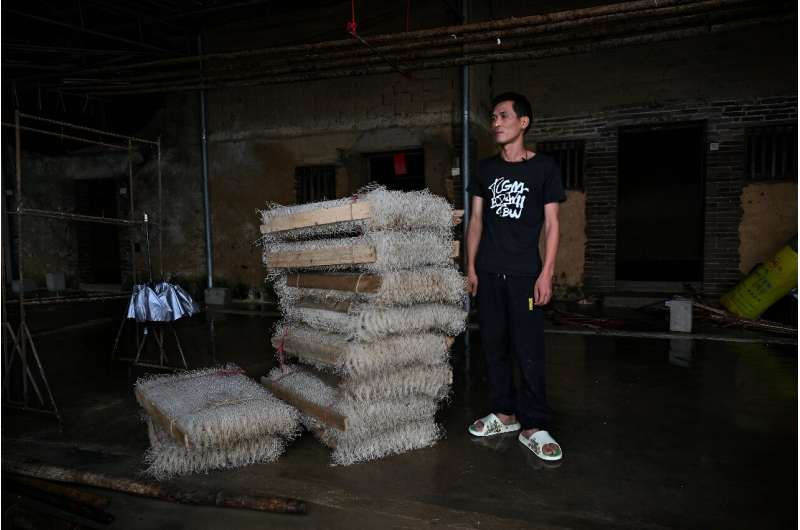
Zhu Huangyi, a local producer of silkworm who lost two thirds of production due to flooding.
Hose in hand, 40-year-old Zhu Huangyi cleans a small concrete room once home to his silkworms, two thirds of which were lost in deadly floods hitting southern China this week.
Just two hours from the economic powerhouse and megacity of Guangzhou, surrounded by lush subtropical vegetation, lies the village of Sancun, one of the worst hit by the recent bad weather.
Around a quarter of households in the village make their living from raising silkworms, insects that secrete precious fibers essential to the textile industry.
Although the water levels had dropped by the time AFP arrived, it reached two meters in some areas—with devastating consequences for residents and the tiny creatures.
“We placed the worms high up but that wasn’t enough,” Zhu Huangyi told AFP, holding up a smartphone showing images of his cocoons floating sadly on the surface of the water.
“It hurts my heart,” he said.
“It’s an old family business, my mother got into this 30 years ago,” says the breeder, whose property was also flooded in 2022.
Behind him, his mother Huang Xiuying scatters white detergent powder on the concrete floor of the enclosures to disinfect the area.
“We continued to feed our worms, even after receiving the weather alert,” she says.
“We couldn’t come to grips with reality,” she explains.
Breeders sell their worms in their cocoon state, when they are most valuable, for around 40 to 50 yuan for a kilo ($5.50 to $7).
Zhu was able to save a third of them.
“After the flood, prices fell,” he says.
Just two hours from the economic powerhouse and megacity of Guangzhou, surrounded by lush subtropical vegetation, lies the village of Sancun, one of the worst-hit by the recent bad weather.
“We were able to sell those that remained at 34 yuan a kilo.”
That was their only way to curb their losses—like many in the village, he had no insurance.
“Basically, it will cost us 40,000 to 50,000 yuan in losses,” he explains—a huge amount in rural China.
‘I lost all my cocoons’
Adding to the pain is the loss in the floods of the village’s mulberry trees, the silkworms’ only source of food.
“The other problem is our mulberry trees,” Zhu said.
The only solution is to cut the heads of the plants once the water level returns to normal, then wait about two weeks for usable leaves to grow back.
Only after that will farmers be able to buy new silkworm eggs to replenish their breeding stock, which Zhu estimates will cost 5,000 yuan.
Another breeder Lan Zhukui is even less fortunate.
“I lost all my cocoons, around 150 kilos of them” with a market value of around 6,000 yuan, he explains to AFP as he cleans the floor of his enclosure.
“There’s not much to do at the moment except wait at home.”
At her breeding station, Huang is more philosophical.
“We’re used to it!” she says. “Before, we were flooded every eight to ten years. Now it’s more like every two years.”
© 2024 AFP
Citation:
In south China, silkworm farmers reel from deadly floods (2024, April 25)
retrieved 25 April 2024
from https://phys.org/news/2024-04-south-china-silkworm-farmers-reel.html
This document is subject to copyright. Apart from any fair dealing for the purpose of private study or research, no
part may be reproduced without the written permission. The content is provided for information purposes only.
>>> Read full article>>>
Copyright for syndicated content belongs to the linked Source : Phys.org – https://phys.org/news/2024-04-south-china-silkworm-farmers-reel.html
